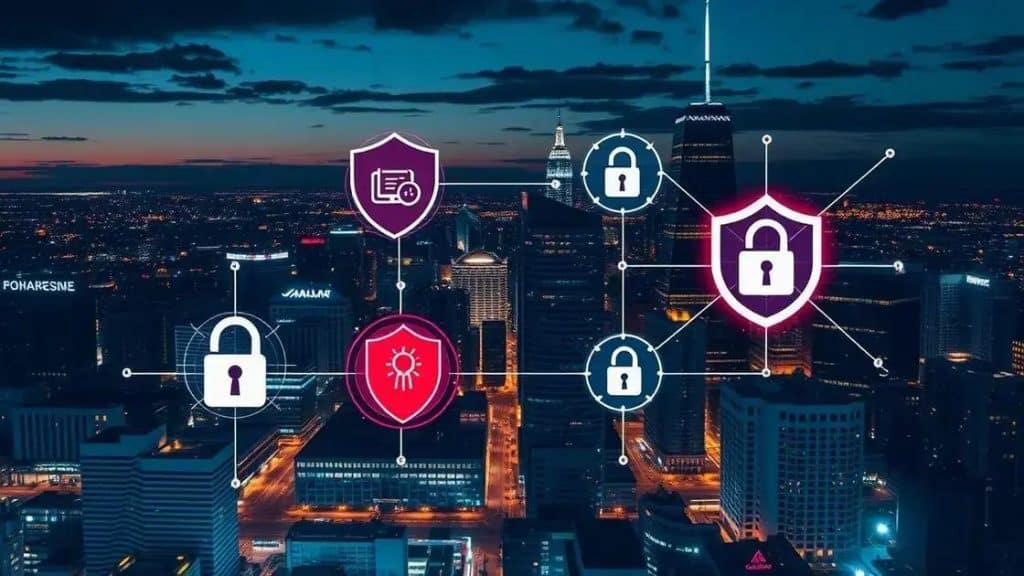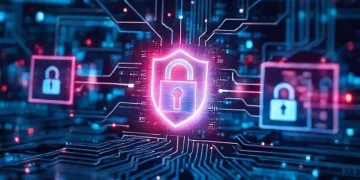City cybersecurity threats 2025: what to expect

City cybersecurity threats in 2025 are evolving with new technologies, requiring cities to adopt advanced security measures, enhance public education, and foster collaboration between sectors to safeguard critical infrastructures effectively.
City cybersecurity threats 2025 promise to be more complex than ever. As urban areas evolve, the risks to digital infrastructures increase. So, how can cities safeguard their networks and citizens from these growing threats? Let’s explore the essentials.
Overview of city cybersecurity threats
Understanding city cybersecurity threats is crucial in today’s digital world. As our cities grow more connected, they become more vulnerable to cyber attacks. Let’s explore the landscape of these emerging threats.
Types of Threats
Cities face various types of cybersecurity threats. These include targeted attacks on critical infrastructures and broader vulnerabilities affecting many systems. Knowing these threats helps cities take action to protect themselves.
- Ransomware attacks on municipal systems
- Data breaches compromising citizen information
- Denial-of-service attacks disrupting services
- Physical attacks on technology infrastructure
Moreover, as technology evolves, so do the methods used by cybercriminals. For instance, new technologies like the Internet of Things (IoT) introduce additional entry points for attackers. These devices often have weak security measures that make them easy targets.
Emerging Attack Vectors
One notable threat is the use of social engineering techniques. Criminals can manipulate individuals to gain access to sensitive systems. Furthermore, supply chain attacks are on the rise, where attackers compromise third-party vendors to infiltrate city networks.
Awareness and training can help mitigate these risks. For example, educating city employees about phishing scams can reduce the likelihood of a successful attack. As threats evolve, so must our defenses.
In addition, leveraging advanced cybersecurity tools can empower cities to stay one step ahead of potential attacks. Continuous monitoring and quick response capabilities are vital in minimizing damage.
By understanding the landscape of city cybersecurity threats, urban leaders can prioritize actions that protect their communities. Awareness is the first step towards a secure digital future.
Top vulnerabilities in urban infrastructure
Urban infrastructure plays a vital role in city life. However, it is also highly vulnerable to cyber threats. Identifying these vulnerabilities is crucial for building a robust defense.
Common Vulnerabilities
Various systems within cities are prime targets for attacks. These can range from public transportation systems to energy grids, each with unique weaknesses. Understanding these vulnerabilities helps in planning effective security measures.
- Weak security protocols in IoT devices
- Outdated software in critical systems
- Insufficient employee training on cybersecurity
- Lack of encryption for sensitive data
Moreover, physical security also matters. Many infrastructure components can be accessed easily, allowing attackers to exploit them directly. For instance, a hacker gaining access to the control room of a subway system can cause chaos.
Software and System Flaws
Another major concern is the potential for software flaws. Many urban infrastructure systems run on complex software, which can have bugs that are hard to detect. These bugs may create loopholes that can be exploited by cybercriminals.
Additionally, cities often rely on third-party vendors for software solutions. If a vendor’s system is compromised, it could open doors for attacks on the city itself. Therefore, ensuring the security of all partners is essential.
Ultimately, addressing these vulnerabilities can make a significant difference. By investing in improved cybersecurity measures, cities can protect their infrastructures and the people who rely on them.
Best practices for cybersecurity in cities

Implementing the best practices for cybersecurity in cities is essential for safeguarding urban infrastructures. A proactive approach can help mitigate threats and protect sensitive data.
Establishing Strong Policies
First, cities should create comprehensive cybersecurity policies. These should outline clear protocols for data protection and incident response. Regular updates to these policies ensure they remain effective against evolving threats.
- Regular cybersecurity training for city employees
- Incident response plans that detail steps to follow during a breach
- Regular audits to assess vulnerabilities
- Restricting access to sensitive systems
Additionally, enforcing strict password requirements can greatly enhance security. Encouraging the use of complex passwords and regular changes can help prevent unauthorized access.
Investing in Technology
Investing in advanced security technologies is also crucial. Cities should consider tools such as firewalls, intrusion detection systems, and data encryption. These technologies create multiple layers of defense against potential attacks.
Moreover, continuous monitoring of all systems is necessary. This helps in detecting suspicious activities early, minimizing potential damage. Involving local law enforcement in cybersecurity initiatives can also foster a strong community response to cyber incidents.
The collaboration between city departments enhances the overall security posture. By sharing information about threats and vulnerabilities, cities can respond more effectively to risks. Strong partnerships with cybersecurity firms can also provide access to the latest strategies and technologies.
In conclusion, adopting best practices for cybersecurity in cities is vital. With a combination of policies, technology, and community involvement, cities can create a safer digital environment.
Impact of new technologies on city security
The impact of new technologies on city security is profound. As cities adopt modern solutions, they also face new challenges. Understanding these effects is crucial for effective urban management.
Emerging Technologies
Innovations like artificial intelligence and the Internet of Things (IoT) significantly enhance city security. These technologies can improve surveillance, data analysis, and threat detection. For example, AI can process vast amounts of data to identify suspicious behavior patterns.
- Automated surveillance systems using facial recognition
- Smart streetlights that detect movement and alert authorities
- Connected sensors monitoring public spaces
- Data analytics for predicting crime hotspots
However, these advancements bring potential risks. A reliance on technology can create vulnerabilities. If systems become compromised, attackers could exploit sensitive information or disrupt city services.
Balancing Innovation and Security
As cities implement new technologies, they need to maintain a balance between innovation and security. Regular updates and patches help protect systems from vulnerabilities. Training staff to recognize cyber threats is also vital for enhancing security posture.
Moreover, public trust is a critical factor. Ensuring transparency in how technologies are used can help alleviate concerns. Engaging the community in discussions about technology implementation fosters a collaborative approach to security.
In summary, while new technologies hold great promise for improving city security, they also require careful consideration. By addressing potential risks and emphasizing security, cities can embrace innovation while protecting their citizens.
Future trends in city cybersecurity
The future of city cybersecurity is set to evolve rapidly, driven by technological advancements and changing threat landscapes. As urban areas become more connected, the need for robust cybersecurity measures will only grow.
Integration of AI and Machine Learning
One major trend is the increased integration of artificial intelligence (AI) and machine learning in cybersecurity strategies. These technologies can help cities analyze vast amounts of data quickly, detecting anomalies that human analysts might miss.
- Predictive analytics to anticipate potential cyber threats
- Automated responses to security breaches
- Enhanced threat detection through pattern recognition
- Continuous learning algorithms to adapt to new tactics
In addition, drone surveillance is becoming popular for monitoring large areas. Drones can provide aerial views of critical infrastructure and identify vulnerabilities in real-time.
Emphasis on Smart Cities
As cities continue to embrace smart technology, the focus on securing these systems will intensify. Smart traffic lights, water systems, and energy grids will need special attention to ensure their safety against cyber threats.
Collaboration between government agencies, private sectors, and communities is vital. By sharing information about threats and best practices, cities can create a more resilient cybersecurity posture.
Moreover, user education will become increasingly important. As cybersecurity threats grow more sophisticated, citizens must be aware of how to protect themselves online. Public awareness campaigns can help educate people about safe practices, such as recognizing phishing attempts or using strong passwords.
Overall, the landscape of city cybersecurity will continue to evolve. Keeping pace with technology and adopting proactive measures will be crucial for safeguarding urban environments in the years ahead.
FAQ – Frequently Asked Questions about City Cybersecurity
What are the main threats to city cybersecurity?
Main threats include ransomware attacks, data breaches, and denial-of-service attacks on critical infrastructure.
How can AI improve city cybersecurity?
AI can analyze large data sets for unusual patterns, enhance threat detection, and automate responses to incidents.
Why is public education important for cybersecurity?
Educating the public helps residents recognize threats like phishing, improving overall community safety.
What role does collaboration play in city cybersecurity?
Collaboration between public and private sectors is crucial to sharing information and developing effective security strategies.





